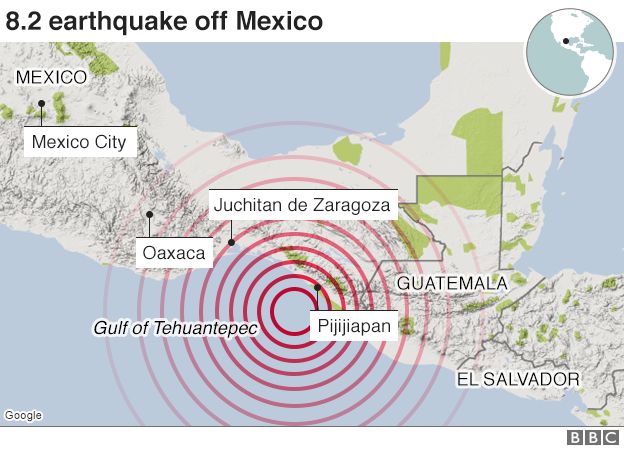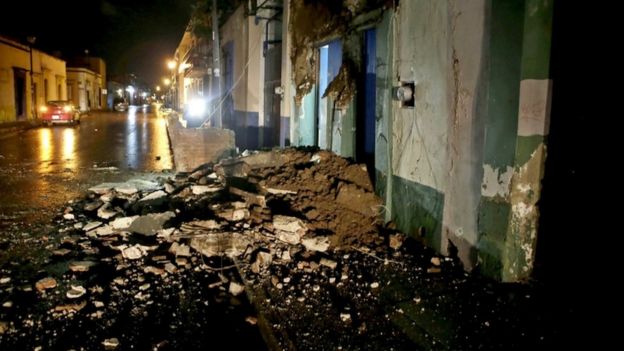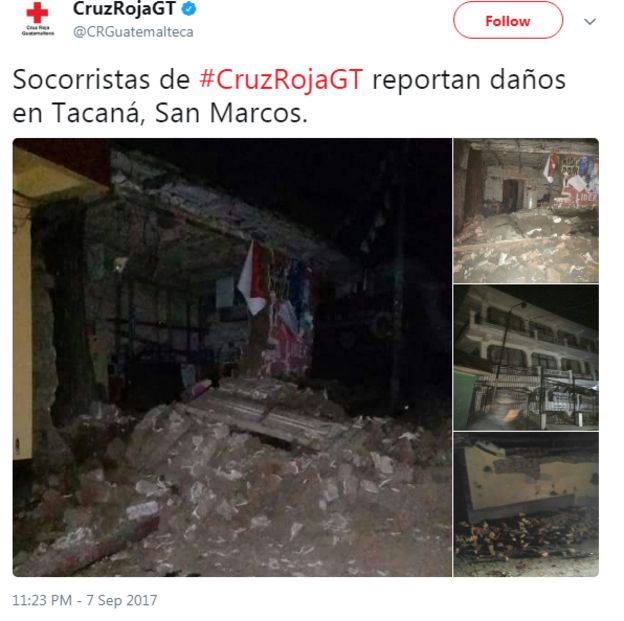Mexico's strongest quake in century strikes off southern coast

An earthquake described by Mexico's president as the country's strongest in a century has struck off the southern coast, killing at least 16 people.
The quake, which President Enrique Peña Nieto said measured 8.2, struck in the Pacific, about 87km (54 miles) south-west of Pijijiapan.
A tsunami warning was issued for Mexico, with three-metre-high waves possible, and other nearby countries.
Severe damage has been reported in Oaxaca and Chiapas states.
The quake, which struck at 23:50 local time on Thursday (04:50 GMT Friday), was felt in Mexico City, with buildings swaying and people running into the street. The tremors there, about 1,000km from the epicentre, were reported to have lasted up to a minute.
President Peña Nieto said some 50 million Mexicans would have felt the tremor and that the death toll might rise.
Among the deaths were at least four in Chiapas. Two children were killed in Tabasco state, one a baby who died when power was cut to a respirator.
One person also died in Guatemala, its president has said.
Ten people are reported dead in Mexico's Oaxaca state.
Social media images showed collapsed buildings in Oaxaca, including in the city of the same name and in Juchitan, where the municipal palace and a number of other structures were levelled.

Local reports speak of a hospital in Juchitan also collapsing.
The Pacific Tsunami Warning Center (PTWC) said that tsunami waves "reaching more than three metres above the tide level are possible along the coasts of Mexico". There is a coastal evacuation in Chiapas state, where a state of emergency has been declared.
The PTWC warned of tsunami threats for El Salvador, Guatemala, Honduras and Costa Rica, but at lower wave levels.
Panic on the streets
BBC's Lourdes Heredia
The earthquake has brought back memories of the tremor of 1985, which left massive destruction in Mexico City and a death toll of 10,000.
This explains the scenes of panic on the streets of the capital, more than 1,000km away from the epicentre. The government does not expect the same scale of physical destruction, as the states most affected are in the poorest and least-developed regions.
Chiapas is the southernmost state, along the Guatemalan border. It's a very mountainous, remote area, where 25% of the population belong to indigenous groups. It's also much visited by tourists seeking to explore some of the best and most well-preserved archaeological treasures, such as the ancient Mayan city of Palenque.
At magnitude 8.2, the quake outstrips the deadly 1985 tremor that hit close to Mexico City and caused thousands of deaths.
The US Geological Survey measured the latest quake slightly lower, at 8.1, saying it struck at a depth of 70km.
 EPA
EPA EPA
EPA
More than a dozen aftershocks ranging from 4.3 to 5.7 in magnitude have been recorded closer to the Mexican coast.
Mr Peña Nieto warned there might be more.
He also said the Salina Cruz refinery on the southern coast had temporarily suspended operations.
Schools have been closed in 11 Mexican states.
Inevitable tremors
Jonathan Amos, BBC science correspondent
This is the biggest quake experienced anywhere in 2017. Going on the statistics, you would expect at least one magnitude 8 to occur somewhere on the planet each year.
It occurred where the Pacific ocean floor is drawn under Mexico and Guatemala. A great slab of rock, known as the Cocos tectonic plate, is driving towards the coast at a rate of 75mm per year. As it jerks downwards into the Earth's interior, about 200km offshore, large tremors are the inevitable outcome.
There have been three magnitude 7s in 2017, with a 7.9 recorded deep under Papua New Guinea back in January. This latest event, being an 8.2, is nearly three times as energetic. That tells you something about how the magnitude scale works.
Fortunately, this event was deep, too. The rupture, which will have ripped across more than 100km of fault line, was down at 70km. That will have limited some of the shaking, but as we've seen there is still extensive damage.
Some electricity cuts have been reported in the capital and social media video showed lampposts and the famous Angel of Independence statue swaying violently, but there are no reports of major damage there.
Journalist Franc Contreras, who is in Mexico City, told the BBC: "You could hear loud cracks in the concrete. It sounded like a giant wooden branch being just broken open violently.
 RED CROSS
RED CROSS
"People were streaming out of the hallways here. And everybody walking out single file into the streets, trying to avoid overhead high power lines."
Guatemalan President Jimmy Morales appealed for calm on national television and in a Twitter post.
"We have reports of some damage and the death of one person, even though we still don't have exact details," Associated Press quoted Mr Morales as saying.
Cindy Lamothe, who is in the Guatemalan city of Antigua, told the BBC: "It was swaying so intensely it felt like we were in a boat and I heard neighbours screaming through the walls... it lasted almost three minutes."
No tsunami warning has been issued for the US west coast.
Mexico is currently also being threatened on its eastern coast by Hurricane Katia.
The category one hurricane is about 300km south-east of Tampico and has sustained winds of 140km/h the National Hurricane Center says.
Thoughts go out to all the people in all the countries suffering right now!!
Yashi Kochi!!!!
Thoughts go out to all the people in all the countries suffering right now!!
Yashi Kochi!!!!


No comments:
Post a Comment